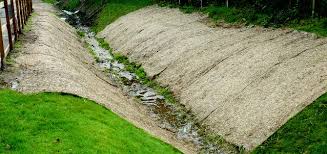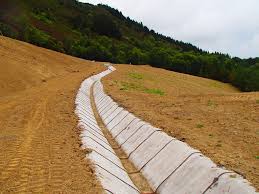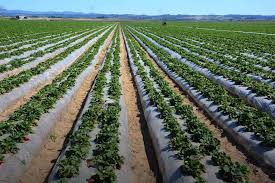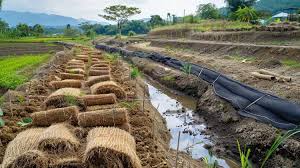Soil erosion is a significant environmental concern that affects agricultural productivity, water quality, and ecosystem health. It occurs when the top layer of soil is removed due to natural processes such as wind and water, as well as human activities like deforestation, overgrazing, and poor agricultural practices.
As soil is eroded, essential nutrients are lost, leading to decreased fertility and compromised land productivity.
This not only threatens food security but also contributes to sedimentation in rivers and streams, adversely impacting aquatic ecosystems.
The impact of soil erosion can be devastating. It can lead to reduced crop yields, increased pollution in waterways, and loss of biodiversity.
According to the Food and Agriculture Organization (FAO), an estimated 24 billion tons of fertile soil are lost each year due to erosion, highlighting the urgent need for effective control strategies.
If left unaddressed, soil erosion can result in desertification and a decline in the ability of land to support both agriculture and natural habitats.
To combat this pressing issue, it is essential to implement effective soil erosion control strategies. These strategies aim not only to protect the soil from erosion but also to enhance its overall health and productivity.
A multi-faceted approach is necessary, as no single solution can address the complex causes of soil erosion. Instead, a combination of practices tailored to specific environmental conditions, land uses, and community needs can provide the most effective results.
One of the primary strategies for soil erosion control is the use of vegetation. Plant roots help bind soil particles together, reducing the likelihood of erosion. Cover crops, grasses, and trees can be planted to create a protective layer on the soil surface.
These plants not only prevent erosion but also improve soil structure and enhance its nutrient content through organic matter addition. Additionally, the use of mulching can protect the soil surface from wind and rain, further minimizing erosion.
Another effective strategy is the implementation of conservation tillage practices. Traditional plowing can expose soil to erosion, so reducing tillage helps maintain soil structure and protect the topsoil.
No-till or reduced-till farming systems leave crop residues on the soil surface, providing a protective layer that shields against erosion while enhancing soil moisture retention and nutrient cycling.
Furthermore, constructing physical barriers such as terraces, check dams, and contour bunds can significantly reduce soil erosion on slopes.
These structures slow down water runoff, allowing for better infiltration and reducing the speed at which soil is carried away. They are particularly effective in hilly or mountainous regions where water runoff is more pronounced.
Educational initiatives also play a crucial role in promoting effective soil erosion control strategies. Raising awareness among farmers and landowners about the importance of soil conservation and the methods available can lead to better land management practices.
Training programs, workshops, and community engagement efforts can foster a culture of sustainable land use, ensuring that soil erosion control measures are implemented effectively.
Soil erosion is a critical issue that requires immediate attention. Implementing effective strategies for soil erosion control is essential for preserving soil health, enhancing agricultural productivity, and protecting ecosystems.
Through a combination of vegetation, conservation tillage, physical barriers, and education, we can create a more sustainable future for our lands and the communities that rely on them.
Understanding Soil Erosion: Causes and Effects

Soil erosion refers to the removal of the top layer of soil, which is crucial for plant growth. Key causes of soil erosion include:
1. Water: Rainfall can dislodge soil particles, leading to runoff and erosion, especially on slopes.
2. Wind: In arid and semi-arid regions, strong winds can lift and transport loose soil particles, causing erosion.
3. Human Activities: Deforestation, overgrazing, and improper agricultural practices can accelerate soil erosion by removing vegetation that holds the soil together.
Effects of Soil Erosion:
i. Loss of Fertility: Erosion depletes the topsoil, which is rich in nutrients essential for plant growth.
ii. Reduced Crop Yields: Erosion can lead to lower agricultural productivity and food insecurity.
iii. Water Quality Issues: Eroded soil can enter water bodies, causing sedimentation and pollution, affecting aquatic life.
iv. Increased Flooding: Erosion can disrupt natural drainage patterns, leading to more frequent flooding.
The Importance of Soil Erosion Control
Controlling soil erosion is vital for maintaining soil health and ensuring sustainable agricultural practices. The importance of erosion control includes:
1. Soil Conservation: Protecting the topsoil preserves its nutrient content, which is essential for crop growth.
2. Enhanced Agricultural Productivity: Erosion control measures help maintain soil structure and fertility, leading to higher crop yields.
3. Environmental Protection: Effective erosion control reduces sedimentation in waterways, protecting aquatic ecosystems and improving water quality.
4. Climate Change Mitigation: Healthy soils act as carbon sinks, helping to sequester carbon dioxide and mitigate climate change impacts.
5. Sustainable Land Use: Implementing erosion control measures promotes sustainable farming practices, ensuring land productivity for future generations.
Types of Soil Erosion: Water, Wind, and Gravity
Soil erosion can occur through various mechanisms, primarily categorized as:
1. Water Erosion:
i. Surface Runoff: Rainfall can cause water to flow over the soil surface, dislodging and carrying soil particles away.
ii. Rill Erosion: Water concentrates in small channels, leading to the formation of rills that deepen and widen over time.
iii. Gully Erosion: Larger channels or gullies form when runoff water removes soil from concentrated areas, leading to significant land loss.
2. Wind Erosion: Wind can detach and lift soil particles, especially in dry, bare areas. This type of erosion is common in arid regions and can lead to the formation of dust storms.
3. Gravity Erosion: Gravity can cause soil to move downhill, especially on steep slopes. This includes mass wasting events like landslides and mudslides, which can significantly alter landscapes.
Vegetative Solutions for Soil Erosion Control
Vegetative solutions use plants to stabilize soil and prevent erosion. Effective techniques include:
1. Cover Cropping: Planting cover crops (e.g., clover, rye) during off-seasons protects the soil from erosion by providing ground cover, improving soil structure, and enhancing nutrient content.
2. Contour Farming: Plowing and planting across the slope of the land helps reduce water runoff and encourages water infiltration into the soil.
3. Agroforestry: Integrating trees into agricultural landscapes can stabilize soil, reduce wind speed, and provide shade and habitat for wildlife.
4. Buffer Strips: Establishing vegetated strips along waterways can filter runoff, trap sediment, and reduce erosion near water bodies.
5. Riparian Zones: Restoring and maintaining vegetated buffers along rivers and streams enhances soil stability and protects water quality.
Read Also: 17 Medicinal Health Benefits Of Bitter Leaf (Vernonia amygdalina)
Structural Techniques for Erosion Control

Structural techniques involve building physical structures to control erosion. Common methods include:
1. Terracing: Creating flat platforms on steep slopes reduces runoff and soil erosion by breaking the slope into smaller, manageable sections.
2. Retaining Walls: Building walls or barriers can help stabilize slopes, preventing soil movement and erosion.
3. Check Dams: Small structures built in gullies can slow down water flow, allowing sediment to settle and reducing erosion.
4. Silt Fences: Installing silt fences along construction sites or disturbed areas can trap sediment and prevent it from entering water bodies.
5. Gabions: Wire mesh baskets filled with rocks can be placed in eroded areas to absorb energy from flowing water and prevent further soil loss.
Using Cover Crops to Prevent Soil Erosion
1. Enhancing Soil Structure: Cover crops, such as clover, rye, or vetch, improve soil structure by increasing organic matter content. This improved structure helps hold soil particles together, reducing the risk of erosion.
2. Reducing Surface Runoff: The roots of cover crops create channels in the soil, which enhances water infiltration and reduces surface runoff. This reduces the amount of water that can erode the soil surface.
3. Suppressing Weeds: Cover crops can suppress weed growth by competing for sunlight, water, and nutrients. Fewer weeds mean less disturbance of the soil, which helps prevent erosion.
4. Providing Ground Cover: During fallow periods, cover crops provide ground cover, protecting the soil from the impact of raindrops and wind, which can cause erosion.
5. Nutrient Cycling: Cover crops improve nutrient cycling by taking up nutrients during the growing season and releasing them back into the soil when they decompose, enhancing soil fertility and reducing erosion.
Benefits of Terracing in Erosion Control
1. Slowing Water Flow: Terracing involves creating flat areas on sloped land to slow down water flow. This slowing reduces the velocity of water, minimizing soil erosion.
2. Increasing Water Retention: Terraces help retain water on the slope, allowing it to infiltrate the soil rather than running off. Increased water retention supports plant growth and reduces erosion.
3. Improved Crop Yield: By controlling erosion and improving water management, terracing can lead to better crop yields. Healthy crops help stabilize the soil, reducing erosion further.
4. Reducing Soil Loss: Terracing effectively reduces soil loss on steep slopes by breaking the slope into manageable sections. Each terrace acts as a barrier to slow down and capture sediment.
5. Enhanced Aesthetic Appeal: Terracing can improve the visual landscape of a farm or garden, creating a more structured and appealing environment while providing erosion control.
Read Also: Significance and Uses of Happy Birthday Flowers
The Role of Mulching in Protecting Soil

1. Protecting Soil Surface: Mulching involves covering the soil with organic or inorganic materials, such as straw, wood chips, or plastic. This covering protects the soil surface from raindrop impact, which can cause erosion.
2. Reducing Water Loss: Mulch helps retain moisture in the soil by reducing evaporation. Moist soil is less prone to erosion, promoting healthier plant growth.
3. Suppressing Weeds: By blocking sunlight, mulch can suppress weed growth. Fewer weeds mean less soil disturbance, which helps prevent erosion.
4. Adding Organic Matter: Organic mulch decomposes over time, adding organic matter to the soil. Increased organic matter improves soil structure and fertility, enhancing erosion resistance.
5. Improving Soil Temperature: Mulch can regulate soil temperature, creating a more favorable environment for plant roots. Healthy plants contribute to soil stability and erosion prevention.
Incorporating Retaining Walls for Erosion Management
1. Creating Flat Areas: Retaining walls can create flat areas on slopes, preventing soil movement and providing stable surfaces for planting. This helps reduce erosion risk.
2. Managing Water Drainage: Retaining walls can effectively manage water drainage on slopes. Proper drainage prevents water buildup, reducing erosion potential.
3. Enhancing Landscape Design: Retaining walls can improve the aesthetic appeal of landscapes while serving a practical purpose in erosion control.
4. Stabilizing Steep Slopes: Retaining walls provide structural support to steep slopes, preventing soil from sliding and eroding during heavy rains or floods.
5. Supporting Vegetation: By creating stable areas for planting, retaining walls can promote vegetation growth. Plant roots help bind the soil together, further reducing erosion risk.
Best Practices for Riparian Buffer Zones
1. Establishing Vegetated Buffers: Riparian buffer zones are vegetated areas near water bodies. Planting native vegetation in these zones helps stabilize soil and prevent erosion along riverbanks and shorelines.
2. Filtering Runoff: Vegetated buffer zones filter agricultural runoff, trapping sediments, nutrients, and pollutants before they enter water bodies. This reduces water pollution and soil erosion.
3. Promoting Biodiversity: Riparian buffers enhance biodiversity by providing habitat for various wildlife species. Healthy ecosystems contribute to soil stability and erosion prevention.
4. Improving Water Quality: By filtering runoff and stabilizing banks, riparian buffer zones improve water quality in nearby streams and rivers, promoting healthier aquatic ecosystems.
5. Regular Maintenance: Maintaining riparian buffer zones is essential for their effectiveness. Regularly assessing and managing vegetation can ensure these areas continue to provide erosion control and water quality benefits.
The Impact of No-Till Farming on Soil Erosion
1. Soil Structure Improvement: No-till farming minimizes soil disturbance by avoiding tilling. This practice helps maintain the natural structure of the soil, promoting better aggregation and reducing erosion.
2. Enhanced Organic Matter: By leaving crop residues on the surface, no-till farming increases organic matter in the soil. This organic matter improves soil health and helps bind soil particles together, reducing erosion risk.
3. Increased Water Infiltration: The undisturbed soil in no-till systems allows for better water infiltration. Improved infiltration reduces surface runoff, which is a significant contributor to soil erosion.
4. Weed Control: No-till farming can help control weeds through crop rotation and cover cropping strategies. Fewer weeds mean less soil disturbance, further minimizing erosion.
5. Carbon Sequestration: No-till farming practices can increase carbon sequestration in the soil, enhancing soil fertility while also contributing to climate change mitigation.
Community Involvement in Erosion Control Initiatives
1. Local Education Programs: Community involvement in erosion control often begins with education. Workshops and seminars can inform farmers and landowners about effective erosion control practices and the importance of soil conservation.
2. Collaborative Projects: Engaging the community in collaborative erosion control projects, such as planting trees or establishing buffer zones, can create a sense of ownership and commitment to soil conservation efforts.
3. Sharing Resources: Communities can pool resources, such as equipment and funding, to implement larger erosion control projects that might be challenging for individual farmers to undertake.
4. Advocacy and Policy Engagement: Communities can advocate for policies and regulations that promote soil conservation practices, such as no-till farming, cover cropping, and support for sustainable agriculture.
5. Monitoring and Feedback: Community involvement also includes monitoring erosion control initiatives and providing feedback. This helps adapt strategies to local conditions and improve overall effectiveness.
Monitoring and Assessing Erosion Control Effectiveness
1. Baseline Data Collection: To assess the effectiveness of erosion control practices, baseline data must be collected on soil health, erosion rates, and other relevant factors before implementation.
2. Regular Monitoring: Ongoing monitoring is crucial to evaluate the impact of erosion control practices over time. This can involve measuring soil loss, changes in vegetation cover, and other indicators of soil health.
3. Use of Technology: Advanced technologies, such as satellite imagery and drones, can provide valuable data for monitoring soil erosion and assessing the effectiveness of various control measures.
4. Community Involvement in Assessment: Engaging local communities in monitoring efforts can enhance the accuracy and reliability of assessments. Community members can provide valuable insights and observations.
5. Reporting and Adaptation: Regular reporting of findings allows for timely adjustments to erosion control practices. Adaptation ensures that methods remain effective and relevant to changing environmental conditions.
Innovative Technologies for Soil Conservation
1. Remote Sensing Technology: Remote sensing allows for large-scale monitoring of soil health and erosion. This technology can help identify areas at risk of erosion and evaluate the effectiveness of conservation practices.
2. Soil Moisture Sensors: These sensors help farmers monitor soil moisture levels in real-time, allowing for better water management. Effective water management reduces erosion caused by surface runoff.
3. Erosion Control Mats: Innovative erosion control mats made from biodegradable materials can protect vulnerable areas during plant establishment. They help stabilize the soil and prevent erosion.
4. Smart Farming Tools: Precision agriculture tools, including GPS-guided equipment and data analytics, help optimize farming practices and reduce soil disturbance, contributing to erosion control.
5. Biotechnological Advances: Biotechnological innovations, such as developing cover crops with enhanced traits for soil conservation, can significantly improve erosion control efforts.
Do you have any questions, suggestions, or contributions? If so, please feel free to use the comment box below to share your thoughts. We also encourage you to kindly share this information with others who might benefit from it. Since we can’t reach everyone at once, we truly appreciate your help in spreading the word. Thank you so much for your support and for sharing!
Read Also: The Different Types of Fertilizers and How they Work
Frequently Asked Questions
We will update this section soon.

